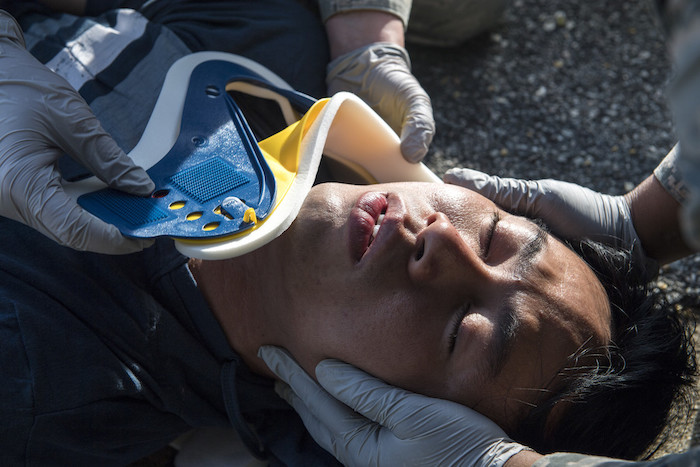Cervical Collar (C-Collar)
Cervical Collar (C-Collar)
David Ray Velez, MD
Table of Contents
Definition and Function
Definition: A Neck Brace Used to Support the Head and Immobilize the Neck
Function: To Immobilize the Neck, Maintain Normal Alignment, and Prevent Further Injury
- *There is No Actual Data to Support Improved Neurologic Outcomes, Prevention of Further Injury, or if Small Voluntary Spinal Movements Cause Harm
Types
Soft Collars
- Felt/Foam Collar that Molds Around the Neck
- Restricts Motion but Does Not Completely Immobilize
- More Comfortable
- Infrequently Used in the Acute Trauma
Rigid Collars
- Rigid Material Used to Completely Immobilize the Neck
- Can be Incorporated into Thoracic Support Devices – Cervical-Thoracic Orthosis (CTO Brace)
- Extrication Collar
- A One-Piece Rigid Collar Used by EMS in the Pre-Hospital Setting
- Intended for Rapid Application but Have Minimal Adjustment with Increased Pressure and Risk for Pressure Injury
- Should Be Exchanged Once the Patient is Stabilized and Appropriate
- Brand Name Two-Piece Rigid Collars:
- Aspen Vista
- Malibu
- Miami J
- Philadelphia
- Comparison:
- Most Restrictive: Miami J and Philadelphia
- Most Comfortable: Aspen Vista

Applying a Rigid Extrication Cervical Collar
“Clearing” a Cervical Collar
Definition: Efforts to Determine if a Cervical Collar is Required or Can Be Removed
Clearing a Cervical Collar
- First Determine if CT is Required (NEXUS Criteria or Canadian C-Spine Rules)
- Positive CT: Requires Neurosurgery or Spine Surgery Evaluation
- Negative CT:
- Alert: Clinically Clear
- Obtunded, Intoxicated, or Non-Examinable:
- Any Focal Neurologic Deficit: MRI
- No Focal Neurologic Deficits: Controversial (Removal vs MRI First)
Clinical Clearance
- Evaluation:
- First: Palpate Along the Cervical Spine for Midline Tenderness
- Lateral Paraspinous Muscle Tenderness is OK
- Second: Evaluate for Pain with Range of Motion (Up/Down and Left/Right)
- First: Palpate Along the Cervical Spine for Midline Tenderness
- Can Remove Collar if There is No Pain Along Midline or with Range of Motion
- If Fails, Consider MRI vs Neurosurgery or Spine Surgery Evaluation
NEXUS (National Emergency X-Radiography Utilization Study) Criteria
- Low-Risk Criteria:
- No Neurologic Deficit
- No Spine (Cervical) Tenderness – Not Perimuscular
- No Altered Mental Status
- Not Intoxicated
- No Distracting Injury
- MNEMONIC: “NSAID”
- All Criteria Met: Can Clinically Clear
- Any Criteria Not Met: Requires CT
Canadian C-Spine Rules
- Rules:
- Rule 1. CT if Any High-Risk Factors
- If None Look at Low-Risk Features
- Rule 2. CT if No Low-Risk Factors Allowing Safe Assessment of Range of Motion
- If At Least One Low-Risk Feature Assess Range of Motion
- Rule 3. CT if Unable to Rotate Neck 45 Degrees Left/Right
- If Able to Rotate Neck, Then Clinically Clear
- Rule 1. CT if Any High-Risk Factors
- High-Risk Features:
- Age ≥ 65 Years
- Dangerous Mechanism:
- Fall ≥ 3 Feet or 5 Stairs
- Axial Load to Head
- High Speed MVC, Rollover or Ejection
- Motorized Recreational Vehicles
- Bicycle Struck or Collision
- Extremity Paresthesia
- Low-Risk Features:
- Simple Rear-Ended MVC
- Sitting Position in ED
- Ambulatory at Any Time
- Delayed Onset of Neck Pain
- No Midline C-Spine Tenderness
Accuracy of High-Quality CT
- 2015 EAST Guidelines:
- 91% Negative Predictive Value for Stable Injuries
- 100% Negative Predictive Value for Unstable Injuries
- 2016 Western Trauma Association Study of Patients that Failed NEXUS Criteria
- 0.03% False Negative Rate for Clinically Significant Injuries – However All Had a Focal Neurologic Abnormality on Their Index Clinical Examination Consistent with Central Cord Syndrome
- For Clinically Significant Injuries:
- 98.5% Sensitivity
- 91.0% Specificity
- 99.97% Negative Predictive Value
Complications
Cervical Collars are Not Totally Benign and Can Be Associated with Several Complications
Uncomfortable
Increased Intracranial Pressure (ICP) – Due to Compression of Jugular Veins and Nociceptive Stimulus
Impedes Airway Management
Increased Risk of Aspiration
Skin Breakdown and Pressure Sores
Challenge for Central Line Placement
